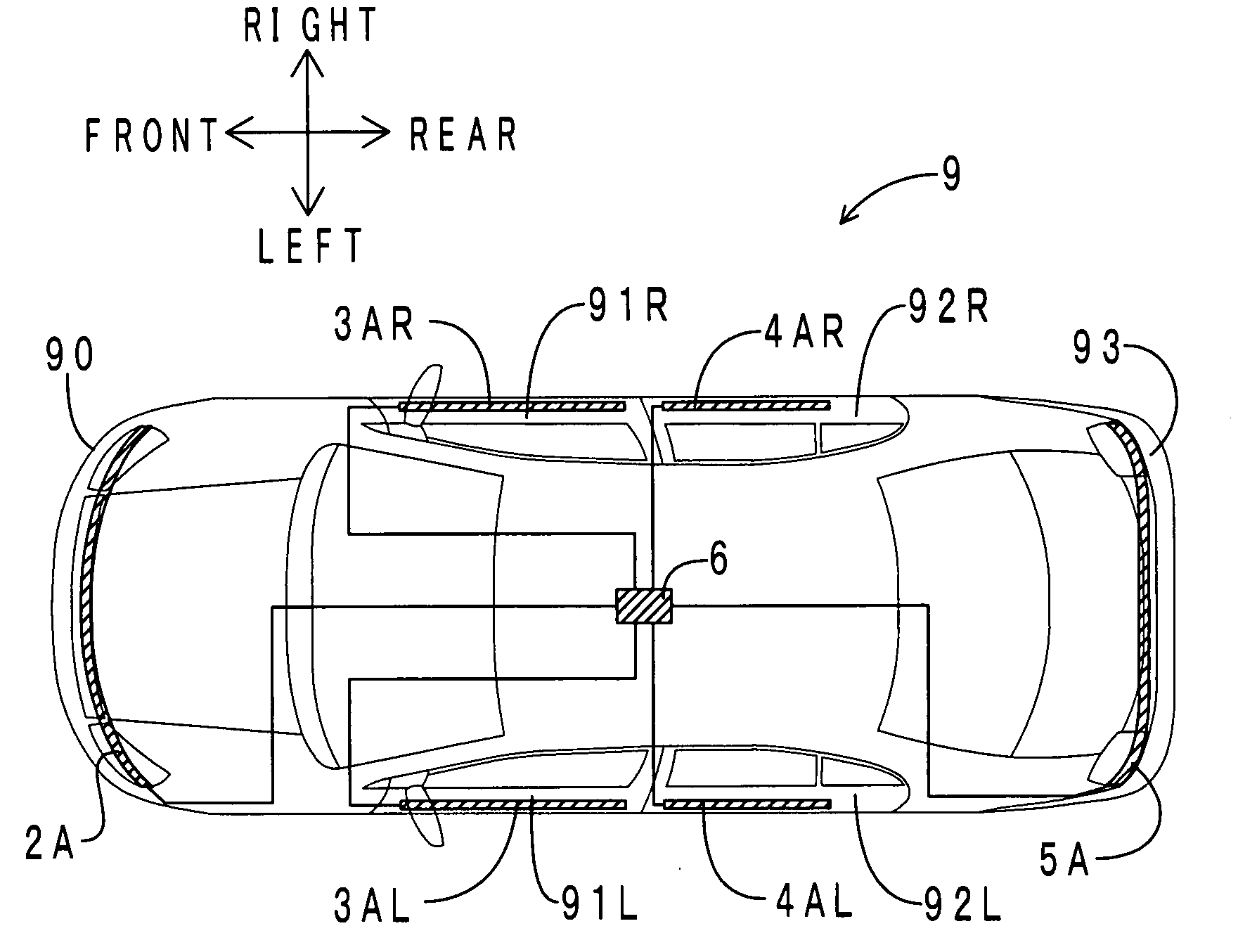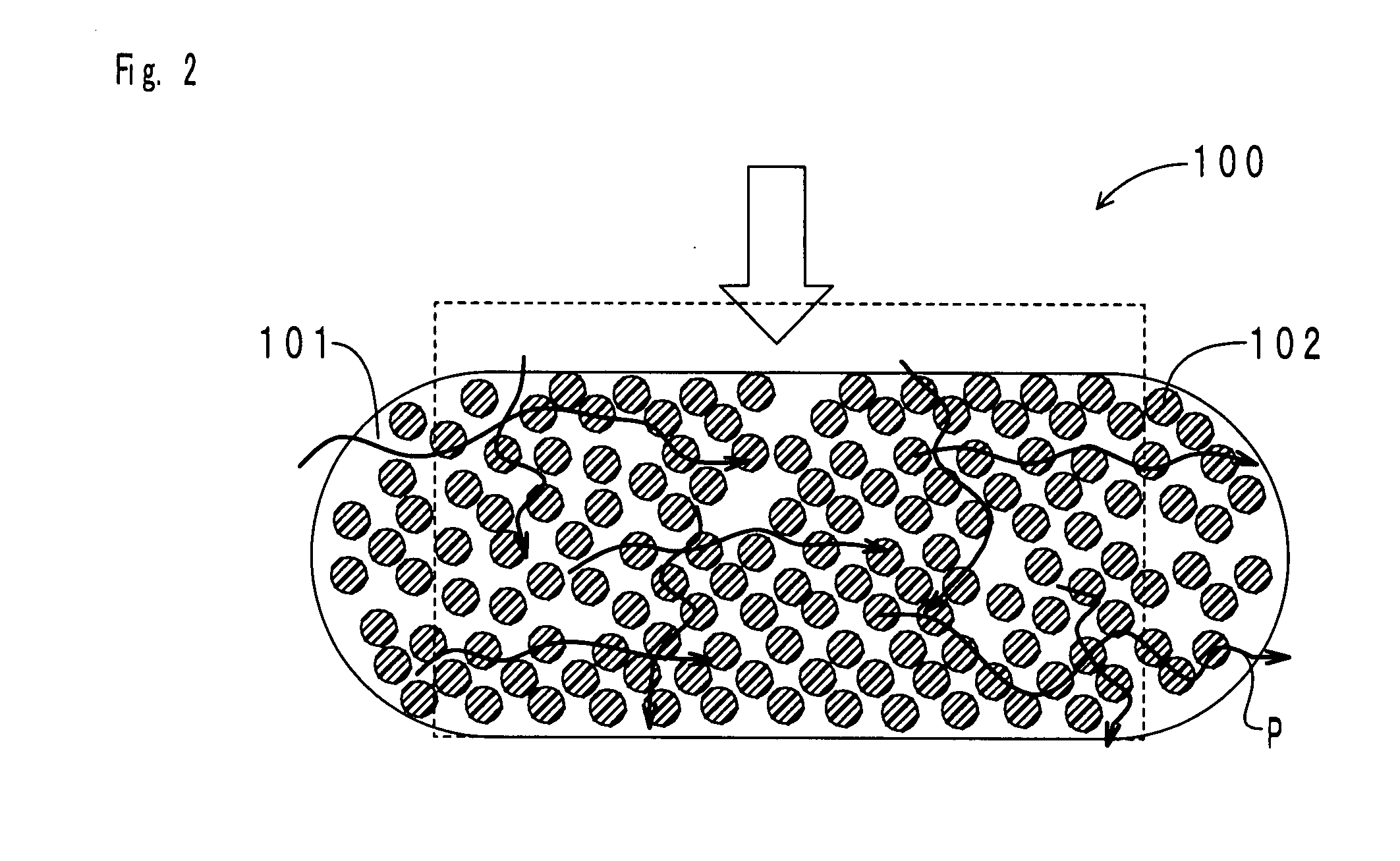Deformation sensor
a technology of deformation sensor and elastomer, which is applied in the direction of instruments, pedestrian/occupant safety arrangements, force/torque/work measurement apparatus, etc., can solve the problems of large shock which requires the operation of the occupant protection device, and achieve excellent compatibility between the conductive filler and the elastomer
- Summary
- Abstract
- Description
- Claims
- Application Information
AI Technical Summary
Benefits of technology
Problems solved by technology
Method used
Image
Examples
first preferred embodiment
[0097]First, an arrangement of the deformation sensor in this preferred embodiment will be explained. FIG. 4(a) is a transmitted upper surface view of a vehicle in which the deformation sensor is arranged. FIG. 4(b) is a transmitted lateral view of the vehicle. By the way, in Figures following to FIG. 4, an orientation is defined on the basis of a forward direction of a vehicle 9.
[0098]As shown in FIG. 4, as for the vehicle 9, a front bumper sensor unit 2A is built in a front bumper 90, a left front door sensor unit 3AL is built in a left front door 91L, a left rear door sensor unit 4AL is built in a left rear door 92L, a right front door sensor unit 3AR is built in a right front door 91R, a right rear door sensor unit 4AR is built in a right rear door 92R, and a rear bumper sensor unit 5A is built in a rear bumper 93, respectively (in FIG. 4, as a matter of convenience for explanation, these sensor units are shown as hatching). Furthermore, under an approximately central floor of t...
second preferred embodiment
[0161]The difference between the first preferred embodiment and this preferred embodiment is that a bridge circuit and an amplifier are shared with respect to all deformation sensors. Therefore, here, only the difference will be explained.
[0162]FIG. 15 is a block diagram of an occupant protection system of this preferred embodiment. By the way, portions corresponding to FIG. 12 are indicated as the same symbols. As shown in FIG. 15, a bridge circuit 62 and an amplifier 63 are arranged in an occupant protection ECU 6.
[0163]FIG. 16 is a circuit diagram of the bridge circuit 62. As shown in FIG. 16, the bridge circuit 62 is connected with each of a front bumper sensor 20, a left front door sensor 30L, a left rear door sensor 40L, a right front door sensor 30R, a right rear door sensor 40R and a rear bumper sensor 50. These sensors are all included in the first deformation sensor of the present invention. Each sensor constitutes a Wheatstone bridge circuit together with resistances R10 ...
third preferred embodiment
[0176]First, an arrangement of the deformation sensor in this preferred embodiment will be explained. FIG. 17 (a) is a transmitted upper surface view of a vehicle in which the deformation sensor is arranged. FIG. 17 (b) is a transmitted lateral view of the vehicle. By the way, portions corresponding to FIG. 4 are indicated as the same symbols.
[0177]As shown in FIG. 17, as for the vehicle 9, a front bumper sensor unit 2B is built in a front bumper 90, a left front door sensor unit 3BL is built in a left front door 91L, a left rear door sensor unit 4BL is built in a left rear door 92L, a right front door sensor unit 3BR is built in a right front door 91R, a right rear door sensor unit 4BR is built in a right rear door 92R, and a rear bumper sensor unit 5B is built in a rear bumper 93, respectively (in FIG. 17, as a matter of convenience for explanation, these sensor units are shown as hatching). Furthermore, under an approximately central floor of the vehicle 9, an occupant protection...
PUM
 Login to View More
Login to View More Abstract
Description
Claims
Application Information
 Login to View More
Login to View More - R&D
- Intellectual Property
- Life Sciences
- Materials
- Tech Scout
- Unparalleled Data Quality
- Higher Quality Content
- 60% Fewer Hallucinations
Browse by: Latest US Patents, China's latest patents, Technical Efficacy Thesaurus, Application Domain, Technology Topic, Popular Technical Reports.
© 2025 PatSnap. All rights reserved.Legal|Privacy policy|Modern Slavery Act Transparency Statement|Sitemap|About US| Contact US: help@patsnap.com



